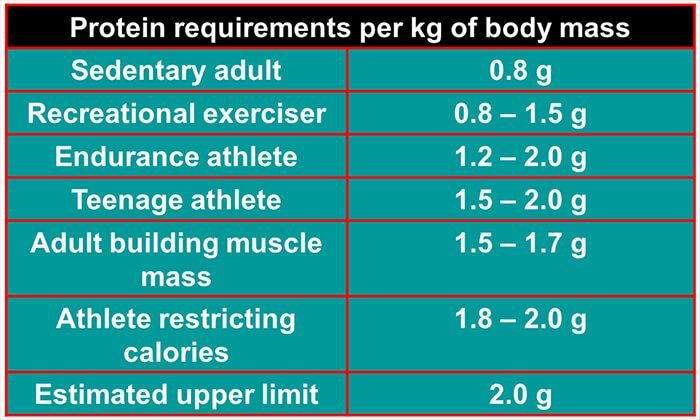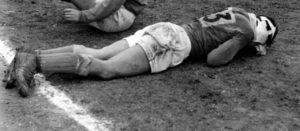Protein is a crucial nutrient for ruggers. Eating too little protein could adversely affect your recovery and performance. Your body uses protein for structure, controlling homeostasis, and, in certain circumstances, for energy. Protein is so important that it’s very name comes from the Greek for first – prōtos.
Why ruggers need protein
Your body is in a constant state of upheaval – it’s a war zone, baby! It’s a never-ending battle between breaking stuff down, a process called catabolism, and growth and repair, a process called anabolism.
Anabolism is dependent on several factors including the anabolic hormones, adequate rest and recovery, and plenty of dietary protein.
Training for rugby and the game itself are both highly catabolic activities. Hard work in the gym and big hits on the pitch take a lot out of your body, causing muscle micro-trauma. Your body needs protein to repair the damage so that, after some well-earned rest, you can come back bigger and stronger than before. Insufficient protein means insufficient material for growth and repair.
We recommend that rugby players consume at least 2 grams of protein / kg or just over 1 gram of protein / lb of body mass.
Amino acids – the protein alphabet
Proteins are made up from building blocks called amino acids. There are 20 of these, and they are best thought of as letters of the protein alphabet. When you eat protein, your body disassembles the protein into its constituent amino acids. Rearranged, it then uses these amino acids according to your physiological needs.
For example, if you eat chicken, your body will take the amino acids in chicken, separate and rearrange them, and then use them to repair your muscles after training. After all, you are not a chicken, you are a rugger!
The 20 amino acids are divided into two groups – essential and non-essential amino acids. Of the 20 amino acids, nine are deemed to be essential, meaning they have to be present in your diet. The remaining 11 are said to be non-essential or conditionally essential because your body can manufacture them if you consume the essentials in sufficient amounts. Both kinds are present in our recovery formula, Post-Rugby.
Complete, incomplete and complementary proteins
Foods that contain all nine essential amino acids are called complete proteins. These include foods such as meat, fish, eggs, whey, soy, blue-green algae, hempseed, buckwheat, and quinoa. If you eat plenty of these foods, your body can synthesize the 11 remaining non-essential/conditionally essential amino acids.
However, lots of other foods contain amino acids, but not enough to be considered fully-fledged complete proteins. These include things like nuts, seeds, pulses, cereals, and vegetables. These foods are called incomplete proteins, and are missing some of the essential amino acids.
By combining incomplete proteins, you can make complete proteins. These are called complementary proteins. Examples include:
- Grains and pulses e.g. rice and beans
- Vegetables and seeds e.g. sesame seed and vegetable stir fry
- Nuts and vegetables e.g. vegetable and nut roast
In the old days of nutritional science, it was thought that, for complementary proteins to work, both foods had to be consumed at the same time. Nowadays, the belief is that incomplete proteins can be consumed within 24 hours of one another to create the complementary protein effect.
The only real disadvantage of complementarily proteins is that they tend to contain a lot more calories than complete proteins.
For example, 100 grams of chicken provides 27 grams of protein and around 240 calories. In contrast, you’d need to consume approximately 500 grams of rice and beans, containing over 700 calories, to achieve a similar amount of protein. Complete proteins are a much more concentrated source of protein than incomplete protein, although protein quality is usually very similar.
So, how much protein do you need?
The amount of protein you need on a daily basis depends on several factors:
- How active you are and the type of activities you do
- Your weight
- Your intake of carbs and calories in general
1) The more active you are, the more protein you need
Physical activity increases catabolism, so you need more protein to repair all that muscle damage. It’s also important to understand that some types of training are much more catabolic than others. Rugby is much more catabolic than badminton!
2) The heavier you are, the more muscle mass you have
…and the more protein you’ll need to sustain it. If you are a beefy front row forward, you need more protein than a fleet-of-foot long distance runner.
3) Fewer carbs require more protein
If you are eating less carbohydrate and/or calories for fat loss, you need more protein to keep you feeling full and prevent the muscle breakdown caused by calorie restriction.
Opinions vary as to how much protein you need but this chart represents ranges that most experts agree on.

When to consume protein
Research suggests that consuming protein in small amounts throughout the day is better than eating fewer, larger portions of protein. Smaller doses create a lasting positive nitrogen balance, which is associated with anabolism.
This helps explain why most protein consumption recommendations suggest consuming 30-gram servings several times per day. However, your body can process more protein than this per serving, so there is no need to stick to the 30-gram rule, especially if you are a big guy who needs to eat a lot of protein.
Most ruggers should include protein at all main meals, and consume high protein snacks too. There are, however, several windows of opportunity when protein consumption is all-but compulsory.
1. Last thing at night – your body does most of its growing and repairing while you sleep. Anabolic hormone levels peak at this time, and so it makes sense to provide your body with the building blocks it needs. Consuming protein last thing at night ensures there are adequate resources for anabolism. Slow acting proteins such as casein, cottage cheese, and full fat, natural yogurt are good choices, but any protein will be beneficial.
2. First thing in the morning – after a night of anabolic growth, recovery, and repair, amino acid supplies are running low, and your body is on the verge of re-entering a catabolic state. Breakfasting on protein can help stop catabolism in its tracks. Pass the eggs, bro!
3. Immediately after training – the sooner you consume protein after training, the faster the recovery process can begin. Fast-acting proteins such as whey are ideal at this time, and liquids will be digested faster than most solids. A post-exercise recovery shake, such as Post Rugby, can also do a lot to put the brakes on catabolism, and kick-start anabolism.
4. Meals where carbs are restricted – if you are eating fewer carbs for weight loss purposes, you should make sure you eat plenty of protein, not least because you’ll need an alternative food to eat. Protein is filling, boosts your metabolism, and will help prevent the muscle breakdown that can be caused by restricting calories.
Can I consume more than two grams of protein per kilo of bodyweight?
A lot of exercisers assume that, when it comes to protein, more is better. They figure that significantly increasing protein intake over and above their actual requirements will lead to faster muscle gain. And while it’s true that too little protein could hurt your progress, consuming more than you need is pointless.
Once your protein requirements are met, any excess will be converted into glucose, and used either for energy or converted to fat and stored for later. Your body WILL try and increase protein metabolism to make use of this excess, but if you continually consume more protein than you need, it just becomes expensive carbs.
How to track protein consumption
The easiest way to make sure you are eating enough protein is to use a food tracker like My Fitness Pal or My Plate. You can set customized goals based on your weight and activity levels to make sure you are not inadvertently consuming too little.
For many, tracking protein intake soon reveals that they aren’t consuming enough, and a few weeks of eating more produces noticeable changes in body composition, strength, recovery, and performance. Yes, you can get by on less protein, but you’ll notice the difference when you start consuming adequate amounts per day.
The easiest way to make sure you are getting enough protein is to make it the cornerstone of every meal. By building your meals around protein, you should have no problem hitting two grams per kilo of bodyweight per day – a good target for most ruggers.
If you’re not looking to supplement your diet with additional protein, we have some different supplements and stacks that might prove useful. Our whey protein isolate, Rugby Whey, is now available in Vanilla, Chocolate, Chocolate Peanut Butter and Cookies N Cream – you get get twice the amount if you go with the twin whey pack. But It’s also available in our Training (Pro), Recovery (Pro) and full supplement stacks.


